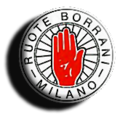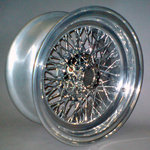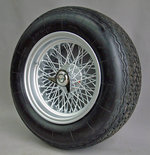Difference between revisions of "Borrani"
m |
m |
||
| (5 intermediate revisions by the same user not shown) | |||
| Line 1: | Line 1: | ||
{{X}} | {{X}} | ||
| − | [[Image:Ruote Borrani Milano logo. | + | [[Image:Ruote Borrani Milano logo.png|center|120px]] |
| − | |||
| + | '''Ruote Borrani S.p.A.''' (established 1922 in [[Milano]]) is an [[Italian]] manufacturer of [[wheel]]s, famous for supplying single-nut lockable [[wire wheels]] to many [[Italian]] [[racing car]]s and [[luxury car]]s up until the 1960s. | ||
| + | [[Image:Borrani wheel.jpg|thumb|left|150px]] | ||
Between 1946 and 1966, all Ferrari cars were equipped with Borrani wheels as original equipment. The two rookies thus share an important part of Italian automotive history, both on the road and on the race track. Afterwards, Borrani wheels remained a major option for Ferrari owners until as late as 1984. | Between 1946 and 1966, all Ferrari cars were equipped with Borrani wheels as original equipment. The two rookies thus share an important part of Italian automotive history, both on the road and on the race track. Afterwards, Borrani wheels remained a major option for Ferrari owners until as late as 1984. | ||
Borrani wheels also were original equipment on famous makes like [[Lamborghini]], [[Alfa Romeo]], [[Maserati]], [[Facel Vega]] and | Borrani wheels also were original equipment on famous makes like [[Lamborghini]], [[Alfa Romeo]], [[Maserati]], [[Facel Vega]] and | ||
[[Aston Martin]]. | [[Aston Martin]]. | ||
| − | + | ||
The company was initially named '''Rudge-Whitworth Milano''', as the splined [[hub]] locking mechanism was licensed from the [[Coventry]]-based [[Rudge Whitworth Cycle Company]], which had developed the patents since 1908. | The company was initially named '''Rudge-Whitworth Milano''', as the splined [[hub]] locking mechanism was licensed from the [[Coventry]]-based [[Rudge Whitworth Cycle Company]], which had developed the patents since 1908. | ||
It was run by [[Carlo Borrani]] at Via Ugo Bassi 9, and quickly became supplier for [[Alfa Romeo]], [[Bianchi (motorcycles)|Bianchi]], [[Lancia]] and other racing cars, used by such drivers as [[Enzo Ferrari]] when winning the first [[Coppa Acerbo]] in [[Pescara]] (1924). Leadership transferred to [[Cesare Borrani]] in 1937. | It was run by [[Carlo Borrani]] at Via Ugo Bassi 9, and quickly became supplier for [[Alfa Romeo]], [[Bianchi (motorcycles)|Bianchi]], [[Lancia]] and other racing cars, used by such drivers as [[Enzo Ferrari]] when winning the first [[Coppa Acerbo]] in [[Pescara]] (1924). Leadership transferred to [[Cesare Borrani]] in 1937. | ||
| − | + | [[Image:DSCF0163.jpg|thumb|right|150px]] | |
It changed its name to '''Ruote Borrani S.p.A.''' in the 1930s, when it also began manufacturing [[aluminum]] (non-wire) wheels to replace [[steel]] wheels. These [[bimetal]] cast-aluminum wheels were standard on [[Maserati 3500]]. | It changed its name to '''Ruote Borrani S.p.A.''' in the 1930s, when it also began manufacturing [[aluminum]] (non-wire) wheels to replace [[steel]] wheels. These [[bimetal]] cast-aluminum wheels were standard on [[Maserati 3500]]. | ||
On relocating, it changed name to '''Costruzioni Meccaniche Rho S.p.A.''' (1955), at a time when 1/10 of the annual volume of about 1,500 wheels were for [[Ferrari]] racing cars; [[motorcycle]]s such as [[Moto-Guzzi]] were other uses. Prototype cars such as the 1953 [[Buick Skylark]] are other examples. | On relocating, it changed name to '''Costruzioni Meccaniche Rho S.p.A.''' (1955), at a time when 1/10 of the annual volume of about 1,500 wheels were for [[Ferrari]] racing cars; [[motorcycle]]s such as [[Moto-Guzzi]] were other uses. Prototype cars such as the 1953 [[Buick Skylark]] are other examples. | ||
| − | In 2004, the Borrani wire wheel production was sold to RuoteMilano srl., member of the international automotive Zeta Europe BV group. The activities were moved to Rozzano on the southern edge of Milan. | + | In 2004, the Borrani wire wheel production was sold to RuoteMilano srl., member of the international automotive Zeta Europe BV group. The activities were moved to Rozzano on the southern edge of Milan. At these new facilities, the traditional production machines were rebuilt and refurbished to meet modern requirements, and to safeguard the quality and production capacity for Borrani wire wheels. Since then, the total product range has become readily available again and a number of models have been re-entered in production. |
| − | At these new facilities, the traditional production machines were rebuilt and refurbished to meet modern | + | |
| + | |||
| + | ==From the Official US website== | ||
| + | |||
| + | On April 22, 1922 '''Rudge Whitworth Milano''' was established in Milan, Italy. The primary focus for the company at that time was production and commercialization of wheels for cars and motorcycles. | ||
| + | |||
| + | Production started with a license from Rudge Whitworth in Coventry, Great Britain, which had registered a patent for mounting a wheel on a hub by a unique splined drum, fixed by one central lock nut. This enabled an easier and faster mounting and dismounting of the wheel. This new system for mounting wheels drew interest from the most elite car makers in the racing industry. Within a year, [[Alfa Romeo]], Auto Union, [[Bianchi]] and [[Lancia]] started to equip their race and luxury cars with Borrani wheels. | ||
| + | |||
| + | In 1924 the young [[Enzo Ferrari]] ran and won the [[Acerbo Cup]] in [[Pescara]] with a car equipped with Rudge Whitworth Milano wire wheels. A partnership was formed and in years to come Borrani rims would become standard on Ferrari models. Other car makers such as Lamborghini and Maserati also found the rims to be ideal for their racing needs. | ||
| + | |||
| + | As early as the 1930’s Borrani started to experiment with light, rigid aluminum rims (cerchi DD) to replace the standard steel wheels. This was the beginning of a technologically advanced way of producing wheels that is still used today. | ||
| + | |||
| + | |||
| + | ==Times of Growth== | ||
| + | |||
| + | In 1952 Enzo Ferrari and Cesare Borrani, Carlo’s son, developed an idea to manufacture special molded hubs. In 1955 the demand for Borrani rims exceeded the current facilities production capabilities and the company relocated to a facility in Baranzate on the northeast side of Milan. | ||
| + | |||
| + | Thousands of national and international victories were achieved on Borrani wire wheels during this period which is why we use the phrase...Wheels of Glory! | ||
| + | |||
| + | Fun Facts | ||
| + | |||
| + | Ford Motor Company purchased rims for the first version of its mythic GT40 and used them on their Le Mans race cars. Between 1950 and 1961 Borrani rims were standard equipment for [[Alfa Romeo]], [[Ferrari]] and [[Maserati]] racers winning eight F1 Driver World Championships and two F1 Manufacturer World Championships ([[Vanwall]] and [[Ferrari]]). Borrani rims contributed to countless Ferrari and Maserati victories in Sport and Prototype races from [[Le Mans]] to [[Nürburgring]], from [[Sebring]] to [[Monza]]. | ||
| + | |||
| + | |||
| + | == The Bimetal Era == | ||
| + | |||
| + | After a successful period for wire wheels, the cast-aluminum wheel gradually took over the market. Looking for new ways to stay competitive, Borrani started to mount a pressed steel wheel disc in their existing aluminum rims. These ‘Bimetal’ wheels, which were produced already in 1950 as CABO wheels, had their fair share of success and were mounted on famous brands as Alfa Romeo, [[ASA]], [[Abarth]], [[Fiat]], [[Lancia]], [[Maserati]] and more. In the early 1960’s, Borrani wire wheels became an exclusive accessory on these manufacturer’s new models. | ||
| + | |||
| + | |||
| + | == Borrani Today == | ||
| + | |||
| + | Since February 2004, Ruote Milano has held the license for the manufacturing of Borrani wire wheels. The new facility is located in [[Rozzano]], in the southern area of [[Milan]]. The rims are still hand-made by highly skilled workers, who guarantee quality and compliance with originality and tradition. Unlike other rim producers only a select number of rims are manufactured every year so the value of the rims stays intact. | ||
| + | |||
| + | With the introduction of the rims into the Americas through Borrani Americas, Ruote Borrani Milano is making their elite wire and bimetallic rims available in limited numbers. | ||
==External links== | ==External links== | ||
| + | *[http://www.velocetoday.com/borrani-and-ferrari/ '''Excellent write-up by Veloce Today'''] | ||
| + | |||
| + | *[http://www.borraniamericas.com/index.html '''Borrani Americas'''] | ||
*[http://www.ruoteborrani.com ruoteborrani.com] | *[http://www.ruoteborrani.com ruoteborrani.com] | ||
*[http://www.borrani.co.uk borrani.co.uk] | *[http://www.borrani.co.uk borrani.co.uk] | ||
| + | |||
Latest revision as of 13:59, 1 February 2012
Ruote Borrani S.p.A. (established 1922 in Milano) is an Italian manufacturer of wheels, famous for supplying single-nut lockable wire wheels to many Italian racing cars and luxury cars up until the 1960s.
Between 1946 and 1966, all Ferrari cars were equipped with Borrani wheels as original equipment. The two rookies thus share an important part of Italian automotive history, both on the road and on the race track. Afterwards, Borrani wheels remained a major option for Ferrari owners until as late as 1984. Borrani wheels also were original equipment on famous makes like Lamborghini, Alfa Romeo, Maserati, Facel Vega and Aston Martin.
The company was initially named Rudge-Whitworth Milano, as the splined hub locking mechanism was licensed from the Coventry-based Rudge Whitworth Cycle Company, which had developed the patents since 1908. It was run by Carlo Borrani at Via Ugo Bassi 9, and quickly became supplier for Alfa Romeo, Bianchi, Lancia and other racing cars, used by such drivers as Enzo Ferrari when winning the first Coppa Acerbo in Pescara (1924). Leadership transferred to Cesare Borrani in 1937.
It changed its name to Ruote Borrani S.p.A. in the 1930s, when it also began manufacturing aluminum (non-wire) wheels to replace steel wheels. These bimetal cast-aluminum wheels were standard on Maserati 3500. On relocating, it changed name to Costruzioni Meccaniche Rho S.p.A. (1955), at a time when 1/10 of the annual volume of about 1,500 wheels were for Ferrari racing cars; motorcycles such as Moto-Guzzi were other uses. Prototype cars such as the 1953 Buick Skylark are other examples.
In 2004, the Borrani wire wheel production was sold to RuoteMilano srl., member of the international automotive Zeta Europe BV group. The activities were moved to Rozzano on the southern edge of Milan. At these new facilities, the traditional production machines were rebuilt and refurbished to meet modern requirements, and to safeguard the quality and production capacity for Borrani wire wheels. Since then, the total product range has become readily available again and a number of models have been re-entered in production.
From the Official US website
On April 22, 1922 Rudge Whitworth Milano was established in Milan, Italy. The primary focus for the company at that time was production and commercialization of wheels for cars and motorcycles.
Production started with a license from Rudge Whitworth in Coventry, Great Britain, which had registered a patent for mounting a wheel on a hub by a unique splined drum, fixed by one central lock nut. This enabled an easier and faster mounting and dismounting of the wheel. This new system for mounting wheels drew interest from the most elite car makers in the racing industry. Within a year, Alfa Romeo, Auto Union, Bianchi and Lancia started to equip their race and luxury cars with Borrani wheels.
In 1924 the young Enzo Ferrari ran and won the Acerbo Cup in Pescara with a car equipped with Rudge Whitworth Milano wire wheels. A partnership was formed and in years to come Borrani rims would become standard on Ferrari models. Other car makers such as Lamborghini and Maserati also found the rims to be ideal for their racing needs.
As early as the 1930’s Borrani started to experiment with light, rigid aluminum rims (cerchi DD) to replace the standard steel wheels. This was the beginning of a technologically advanced way of producing wheels that is still used today.
Times of Growth
In 1952 Enzo Ferrari and Cesare Borrani, Carlo’s son, developed an idea to manufacture special molded hubs. In 1955 the demand for Borrani rims exceeded the current facilities production capabilities and the company relocated to a facility in Baranzate on the northeast side of Milan.
Thousands of national and international victories were achieved on Borrani wire wheels during this period which is why we use the phrase...Wheels of Glory!
Fun Facts
Ford Motor Company purchased rims for the first version of its mythic GT40 and used them on their Le Mans race cars. Between 1950 and 1961 Borrani rims were standard equipment for Alfa Romeo, Ferrari and Maserati racers winning eight F1 Driver World Championships and two F1 Manufacturer World Championships (Vanwall and Ferrari). Borrani rims contributed to countless Ferrari and Maserati victories in Sport and Prototype races from Le Mans to Nürburgring, from Sebring to Monza.
The Bimetal Era
After a successful period for wire wheels, the cast-aluminum wheel gradually took over the market. Looking for new ways to stay competitive, Borrani started to mount a pressed steel wheel disc in their existing aluminum rims. These ‘Bimetal’ wheels, which were produced already in 1950 as CABO wheels, had their fair share of success and were mounted on famous brands as Alfa Romeo, ASA, Abarth, Fiat, Lancia, Maserati and more. In the early 1960’s, Borrani wire wheels became an exclusive accessory on these manufacturer’s new models.
Borrani Today
Since February 2004, Ruote Milano has held the license for the manufacturing of Borrani wire wheels. The new facility is located in Rozzano, in the southern area of Milan. The rims are still hand-made by highly skilled workers, who guarantee quality and compliance with originality and tradition. Unlike other rim producers only a select number of rims are manufactured every year so the value of the rims stays intact.
With the introduction of the rims into the Americas through Borrani Americas, Ruote Borrani Milano is making their elite wire and bimetallic rims available in limited numbers.


